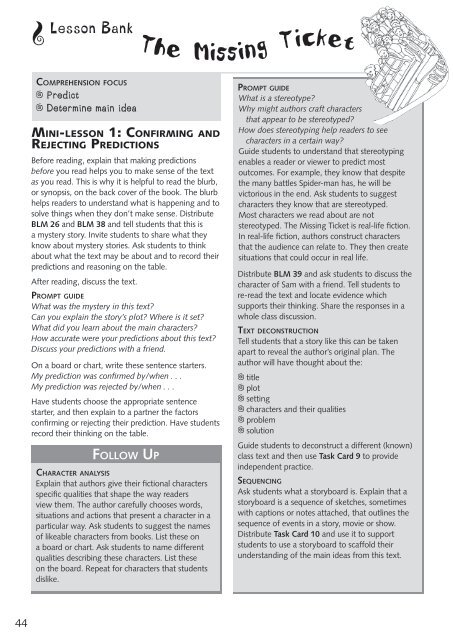All You Need To Teach Comprehension 10+
Create successful ePaper yourself
Turn your PDF publications into a flip-book with our unique Google optimized e-Paper software.
Lesson Bank<br />
The Missing Ticket<br />
<strong>Comprehension</strong> focus<br />
@ Predict<br />
@ Determine main idea<br />
Mini-lesson 1: Confirming and<br />
Rejecting Predictions<br />
Before reading, explain that making predictions<br />
before you read helps you to make sense of the text<br />
as you read. This is why it is helpful to read the blurb,<br />
or synopsis, on the back cover of the book. The blurb<br />
helps readers to understand what is happening and to<br />
solve things when they don’t make sense. Distribute<br />
BLM 26 and BLM 38 and tell students that this is<br />
a mystery story. Invite students to share what they<br />
know about mystery stories. Ask students to think<br />
about what the text may be about and to record their<br />
predictions and reasoning on the table.<br />
After reading, discuss the text.<br />
Prompt guide<br />
What was the mystery in this text?<br />
Can you explain the story’s plot? Where is it set?<br />
What did you learn about the main characters?<br />
How accurate were your predictions about this text?<br />
Discuss your predictions with a friend.<br />
On a board or chart, write these sentence starters.<br />
My prediction was confirmed by/when . . .<br />
My prediction was rejected by/when . . .<br />
Have students choose the appropriate sentence<br />
starter, and then explain to a partner the factors<br />
confirming or rejecting their prediction. Have students<br />
record their thinking on the table.<br />
Follow Up<br />
Character analysis<br />
Explain that authors give their fictional characters<br />
specific qualities that shape the way readers<br />
view them. The author carefully chooses words,<br />
situations and actions that present a character in a<br />
particular way. Ask students to suggest the names<br />
of likeable characters from books. List these on<br />
a board or chart. Ask students to name different<br />
qualities describing these characters. List these<br />
on the board. Repeat for characters that students<br />
dislike.<br />
Prompt guide<br />
What is a stereotype?<br />
Why might authors craft characters<br />
that appear to be stereotyped?<br />
How does stereotyping help readers to see<br />
characters in a certain way?<br />
Guide students to understand that stereotyping<br />
enables a reader or viewer to predict most<br />
outcomes. For example, they know that despite<br />
the many battles Spider-man has, he will be<br />
victorious in the end. Ask students to suggest<br />
characters they know that are stereotyped.<br />
Most characters we read about are not<br />
stereotyped. The Missing Ticket is real-life fiction.<br />
In real-life fiction, authors construct characters<br />
that the audience can relate to. They then create<br />
situations that could occur in real life.<br />
Distribute BLM 39 and ask students to discuss the<br />
character of Sam with a friend. Tell students to<br />
re-read the text and locate evidence which<br />
supports their thinking. Share the responses in a<br />
whole class discussion.<br />
Text deconstruction<br />
Tell students that a story like this can be taken<br />
apart to reveal the author’s original plan. The<br />
author will have thought about the:<br />
@ title<br />
@ plot<br />
@ setting<br />
@ characters and their qualities<br />
@ problem<br />
@ solution<br />
Guide students to deconstruct a different (known)<br />
class text and then use Task Card 9 to provide<br />
independent practice.<br />
Sequencing<br />
Ask students what a storyboard is. Explain that a<br />
storyboard is a sequence of sketches, sometimes<br />
with captions or notes attached, that outlines the<br />
sequence of events in a story, movie or show.<br />
Distribute Task Card 10 and use it to support<br />
students to use a storyboard to scaffold their<br />
understanding of the main ideas from this text.<br />
44


















